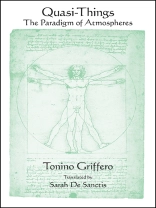An aesthetic and phenomenological account of feelings.
In this book, Tonino Griffero introduces and analyzes an ontological category he terms ‘quasi-things.’ These do not exist fully in the traditional sense as substances or events, yet they powerfully act on us and on our states of mind. He offers an original approach to the study of emotions, regarding them not as inner states of the subject, but as atmospheres, that is as powers poured out into the lived space we inhabit. Griffero first outlines the general and atmospheric characters of quasi-things, and then considers examples such as pain, shame, the gaze, and twilight-which he argues is responsible for penetrating and suggestive moods precisely because of its vagueness. With frequent examples from literature and everyday life, Quasi-Things provides an accessible aesthetic and phenomenological account of feelings based on the paradigm of atmospheres.
Daftar Isi
Preface
1. Quasi-Things Come and Go and We Cannot Wonder Where They’ve Been (Starting from the Wind)
2. Quasi-Things Assault and Resist Us: Feelings as Atmospheres
3. Quasi-Things Are Felt (though Not Localized): The Isles of the Felt-Body
4. Quasi-Things Are Proofs of Existence: Pain as the Genesis of the Subject
5. Quasi-Things Affect Us (Also Indirectly): Vicarious Shame
6. Quasi-Things Communicate with Us: From the Gaze to the Portrait (and Back)
7. Quasi-Things Are the More Effective the Vaguer They Are: Twilightness
Notes
Bibliography
Index
Tentang Penulis
Tonino Griffero is Full Professor of Aesthetics at the University of Rome Tor Vergata and the author of many books, including Atmospheres: Aesthetics of Emotional Spaces, translated by Sarah De Sanctis. Sarah De Sanctis is General Manager of the UK branch of Labont (Laboratory for Ontology). She is the translator of Manifesto of New Realism, by Maurizio Ferraris, also published by SUNY Press.












